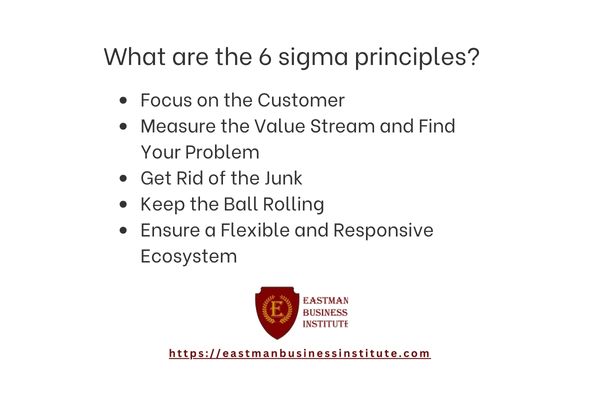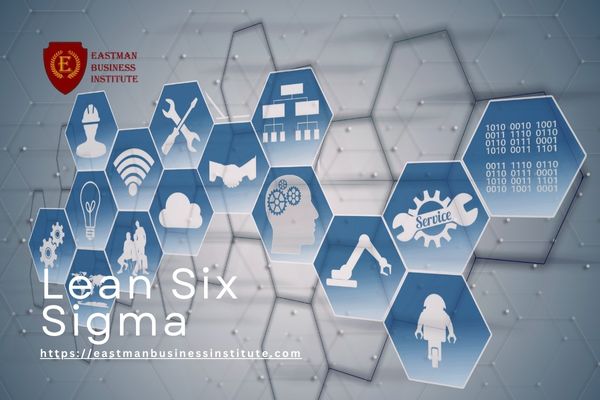Are you looking to enhance your business processes and improve efficiency? Lean Six Sigma is the answer.
We will guide you through the principles and methodologies of Lean Six Sigma, highlighting its benefits and real-life success stories.
Read more about Lean Six Sigma Knowledge

Discover how Lean Six Sigma can be implemented in various industries and overcome challenges along the way.
Join us as we explore the exciting future of Lean Six Sigma and its potential to revolutionize business operations.
More Things To Know About Lean Six Sigma Knowledge

Understanding Lean Six Sigma
Now, let’s start by understanding the key points of Lean Six Sigma.
The core principles of Lean Six Sigma involve identifying and reducing variation, maximizing value for the customer, and continuously improving processes.
Definition and Origin of Lean Six Sigma
Lean Six Sigma is a methodology for process improvement that combines the principles of Lean Manufacturing and Six Sigma. It aims to reduce waste and variation in processes, leading to improved efficiency and quality.
The origin of Lean Six Sigma can be traced back to the 1980s when Motorola and General Electric popularized Six Sigma to enhance their manufacturing processes.
Lean Manufacturing has its roots in the Toyota Production System developed in the 1950s.
The combination of these two approaches resulted in Lean Six Sigma, which has gained widespread recognition and is now commonly used in various industries.
Professionals can obtain Lean Six Sigma certification to demonstrate their expertise in implementing these methodologies and driving continuous improvement.
Principles of Lean Six Sigma
The Six Sigma principles aim to reduce defects and variation in processes, ensuring high-quality outputs. By integrating these two methodologies, Lean Six Sigma provides a holistic approach to process improvement. It emphasizes the importance of continuous improvement, data-driven decision-making, and the involvement of all stakeholders.
Understanding the principles of Lean Six Sigma is crucial for organizations aiming to optimize their operations and deliver superior products and services.
The Lean Six Sigma Methodology
Now let’s talk about the key points of the Lean Six Sigma Methodology.
This methodology is based on two main processes: the DMAIC process and the DMADV process.
These processes provide a structured framework for problem-solving and process improvement, enabling organizations to identify and eliminate waste, reduce variation, and improve overall efficiency and quality.
DMAIC (Define, Measure, Analyze, Improve, Control) Process
When implementing Lean Six Sigma, you can begin by utilizing the DMAIC (Define, Measure, Analyze, Improve, Control) process. This process serves as a roadmap for achieving process improvement and eliminating defects.
First, you must define the problem or opportunity for improvement, clearly stating the goals and objectives.
Next, you measure the current performance of the process using data and metrics. This step helps identify gaps and areas for improvement.
Once you have gathered the necessary data, it’s time to analyze it to understand the root causes of the problem. This analysis guides the improvement phase, where you develop and implement solutions to address the identified issues.
Finally, you establish control measures to sustain the improvements and continuously monitor the process to maintain the desired results.
DMADV (Define, Measure, Analyze, Design, Verify) Process
Start by understanding the DMADV (Define, Measure, Analyze, Design, Verify) Process, a key component of the Lean Six Sigma methodology.
The DMADV process is a systematic approach used to develop new products, services, or processes. It begins with defining the problem or opportunity and setting clear objectives.
Next, you measure the current performance and gather data to analyze the root causes of any issues. Once the analysis is complete, you move on to the design phase, where you develop and test potential solutions.
Benefits of Implementing Lean Six Sigma
When you implement Lean Six Sigma, you can expect increased efficiency and productivity in your organization. This methodology focuses on eliminating waste and streamlining processes, allowing you to get more done with less effort.
You’ll see an improvement in the quality of your products or services as Lean Six Sigma helps identify and eliminate defects or errors.
Lastly, implementing Lean Six Sigma can lead to cost reduction and profit maximization as you optimize your processes and eliminate unnecessary expenses.
Increased Efficiency and Productivity
By implementing Lean Six Sigma principles, you can identify and eliminate non-value-added activities, streamline processes, and optimize resource utilization. This leads to increased efficiency and productivity, as your organization becomes more streamlined and effective in delivering products or services.
Continuous improvement is a key aspect of Lean Six Sigma, which means that you’re constantly seeking ways to improve processes, eliminate defects, and enhance customer satisfaction.
Lean management techniques and improvement projects are also integral to Lean Six Sigma, as they help you identify and address areas of improvement within your organization.
Improved Quality of Products or Services
By implementing Lean Six Sigma, you can enhance the quality of your products or services. Lean Six Sigma is a methodology that focuses on reducing variations and eliminating defects in processes. This improvement approach emphasizes the importance of customer satisfaction and continuous improvement.
Through the implementation of Lean Six Sigma, you can identify and address the root causes of quality issues, resulting in improved quality of your products or services. By using data-driven analysis and statistical tools, you can identify areas for improvement, streamline processes, and eliminate waste. This leads to increased customer satisfaction, reduced defects, and improved overall quality.
Implementing Lean Six Sigma enables you to deliver products or services that meet or exceed customer expectations, enhancing your reputation and competitive advantage.
Cost Reduction and Profit Maximization
You can achieve cost reduction and profit maximization by implementing Lean Six Sigma. Lean Six Sigma is a business strategy that combines the principles of lean manufacturing and operational excellence with the methodologies of Six Sigma. By using Lean Six Sigma, organizations can identify and eliminate waste, reduce defects, and streamline processes, leading to significant cost savings and improved profitability.
To illustrate the benefits of implementing Lean Six Sigma, consider the following table:
| Benefits of Lean Six Sigma | Description |
| Cost savings | Lean Six Sigma helps identify and eliminate inefficient processes, resulting in cost reduction and increased profitability. |
| Process improvements | By continuously analyzing and improving processes, Lean Six Sigma helps optimize operations, leading to increased efficiency and productivity. |
| Business strategy | Lean Six Sigma can be integrated into the overall business strategy to drive sustainable growth and competitive advantage. |
| Operational excellence | Implementing Lean Six Sigma fosters a culture of continuous improvement and operational excellence throughout the organization. |
| Six Sigma methodologies | Lean Six Sigma provides a structured approach for problem-solving and data-driven decision-making, which leads to better outcomes and higher profits. |
Roles and Responsibilities in Lean Six Sigma
Now let’s talk about the roles and responsibilities in Lean Six Sigma.
At each belt level, whether it’s Yellow, Green, Black, or Master Black, there are specific skills required and tasks to be fulfilled.
It’s important to understand the different responsibilities and expectations associated with each level to effectively contribute to the Lean Six Sigma process.
Overview of Different Belt Levels (Yellow, Green, Black, Master Black)
Lean Six Sigma utilizes different belt levels, including Yellow, Green, Black, and Master Black, each with its distinct roles and responsibilities.
The Yellow Belt level is the entry level and provides a basic understanding of Lean Six Sigma principles and tools. Yellow Belts typically support project teams by collecting data and performing simple analyses.
Green Belts are the next level and are responsible for leading smaller projects within their areas of expertise. They work closely with Black Belts and assist in data collection, analysis, and implementation of improvement initiatives.
Black Belts are highly skilled professionals who lead and manage larger improvement projects. They have a deep understanding of Lean Six Sigma methodology and statistical analysis.
Responsibilities and Skills Required at Each Level
The responsibilities and skills required at each level in Lean Six Sigma vary significantly.
At the Lean Six Sigma Yellow Belt level, individuals are introduced to the basic concepts and tools of Lean Six Sigma. They’re responsible for actively participating in process improvement projects and assisting Green Belts and Black Belts. Strong analytical and problem-solving skills are essential at this level.
Moving up to the Lean Six Sigma Green Belt level, individuals are expected to lead small to medium-sized improvement projects. They must possess a deep understanding of Lean Six Sigma methodologies and tools, as well as the ability to analyze data, identify root causes, and implement sustainable solutions.
At the highest level, the Lean Six Sigma Black Belt, individuals are responsible for leading complex improvement projects and mentoring Green Belts. They must have exceptional leadership, project management, and statistical analysis skills. Black Belts are expected to drive significant organizational change and deliver measurable results.
Lean Six Sigma in Different Industries
Now let’s talk about how Lean Six Sigma is applied in different industries.
In manufacturing, Lean Six Sigma helps improve efficiency, reduce waste, and enhance product quality.
In healthcare, it focuses on improving patient safety, reducing errors, and streamlining processes.
In the IT industry, Lean Six Sigma aids in optimizing software development, improving system performance, and enhancing customer satisfaction.
Application of Lean Six Sigma in Manufacturing
You can apply the Lean Six Sigma methodology in various manufacturing industries. It has been successfully implemented in industries such as automotive, electronics, pharmaceuticals, and food production.
By applying Lean Six Sigma principles, manufacturing companies can streamline their processes, improve product quality, and increase customer satisfaction. The application of Lean Six Sigma in manufacturing involves identifying and analyzing areas of improvement, implementing Lean and Six Sigma tools and techniques, and continuously monitoring and measuring performance to sustain improvements.
Some commonly used tools and techniques include value stream mapping, 5S, kaizen, DMAIC, and statistical analysis.
With Lean Six Sigma, manufacturing industries can achieve higher efficiency, reduced costs, and increased competitiveness in the market.
Application of Lean Six Sigma in Healthcare
Implement Lean Six Sigma methodology to optimize processes and minimize errors in healthcare, enhancing efficiency and improving patient outcomes.
Lean Six Sigma, a powerful problem-solving approach, has gained popularity in various industries, including healthcare. Its application in healthcare aims to improve process efficiency, reduce costs, and enhance customer satisfaction.
By using statistical analysis and data-driven decision-making, Lean Six Sigma identifies and eliminates waste, streamlines workflows, and improves patient care delivery.
Through continuous improvement, healthcare organizations can achieve higher quality standards, reduce medical errors, and enhance patient safety.
The application of Lean Six Sigma in healthcare not only improves operational efficiency but also fosters a culture of continuous learning and innovation.
Application of Lean Six Sigma in IT
Applying Lean Six Sigma methodology in the IT industry optimizes processes and minimizes errors, enhancing efficiency and improving outcomes. Here are three ways in which Lean Six Sigma can be applied in IT:
- Streamlining IT processes: By using Lean Six Sigma methodologies, IT professionals can identify and eliminate waste, reducing the time and effort required to complete tasks and deliver IT services. This leads to faster response times, improved customer satisfaction, and cost savings.
- Improving IT project management: Lean Six Sigma can be utilized to analyze and improve project management processes in IT. By identifying and addressing bottlenecks, delays, and inefficiencies, IT projects can be completed on time, within budget, and with better quality.
- Enhancing IT service delivery: Lean Six Sigma can be applied to analyze and improve IT service delivery processes, such as incident management, problem management, and change management. This helps in reducing service disruptions, improving service levels, and increasing customer satisfaction.
Challenges and Solutions in Lean Six Sigma Implementation
Now let’s talk about the common challenges you may face when implementing Lean Six Sigma and the strategies you can use to overcome them.
Implementing Lean Six Sigma can be a complex process, and some of the challenges you may encounter include:
- Resistance to change
- Lack of leadership support
- Difficulty in sustaining improvements
By adopting a proactive approach, involving all stakeholders, and providing adequate training and support, you can successfully navigate these challenges and ensure the successful implementation of Lean Six Sigma in your organization.
Common Challenges in Implementing Lean Six Sigma
Implementing Lean Six Sigma can present various challenges that organizations need to address to achieve successful outcomes.
One common challenge is resistance from employees and process managers who may be resistant to change or skeptical about the benefits of Lean Six Sigma. This can hinder the adoption and implementation of Lean Six Sigma methodologies within an organization.
Another challenge is ensuring that the improvement efforts are focused on the right areas. Without proper prioritization and alignment with business goals, the implementation of Lean Six Sigma may not yield the desired results in terms of process performance and problem-solving.
Sustaining the improvements achieved through Lean Six Sigma can be a challenge. Organizations need to have a system in place to continuously monitor and improve their processes to ensure long-term success.
Strategies to Overcome These Challenges
To successfully overcome these challenges in Lean Six Sigma implementation, you should consistently and proactively address them.
One of the key strategies is to invest in certification training for your team. This will ensure that they have the necessary knowledge and skills to effectively implement the improvement process.
It’s crucial to develop strategies to manage process variations. This can be done by using tools and techniques such as statistical process control and design of experiments.
Another important strategy is to establish a culture of continuous improvement within your organization. Encourage employees to identify and solve problems on an ongoing basis.
Future of Lean Six Sigma
As you look towards the future of Lean Six Sigma, it’s important to consider the emerging trends in this field. These trends are shaping the way Lean Six Sigma is implemented and practiced, and staying updated will be crucial for success.
The impact of technology on Lean Six Sigma can’t be ignored, as advancements in technology continue to transform the way processes are managed and improved.
Trends in Lean Six Sigma
The future of Lean Six Sigma is driven by emerging trends and best practices.
One of the key trends in Lean Six Sigma is the increasing demand for advanced certifications. Organizations are recognizing the value of employees who’ve obtained specialized knowledge and skills in Lean Six Sigma methodologies.
Another trend is the growing importance of statistics in Lean Six Sigma. Data analysis and statistical tools are essential for identifying process improvement opportunities and making data-driven decisions.
There’s a shift towards online Lean Six Sigma training, as it offers flexibility and accessibility to individuals looking to enhance their skills.
Impact of Technology on Lean Six Sigma
One important trend shaping the future of Lean Six Sigma is the increasing impact of technology on its methodologies and practices.
Technology has revolutionized the way businesses operate, and Lean Six Sigma is no exception. The integration of technology has improved the efficiency and effectiveness of Lean Six Sigma processes, allowing organizations to achieve higher levels of productivity and quality.
With the advent of advanced data analytics and automation tools, businesses can now collect and analyze large amounts of data in real-time, enabling them to identify process bottlenecks and make data-driven decisions.
Technology has made Lean Six Sigma more accessible by offering online Six Sigma certification programs and providing digital platforms for collaboration and knowledge sharing.
As technology continues to evolve, its impact on Lean Six Sigma will only grow, making it an essential component of modern business processes.
Frequently Asked Questions (FAQs)
What Are the Main Differences Between Lean Six Sigma and Traditional Six Sigma Methodologies?
The main differences between traditional Six Sigma and Lean Six Sigma methodologies are the integration of lean principles, focus on reducing waste, and emphasis on continuous improvement.
How Does Lean Six Sigma Address Waste Reduction and Process Improvement?
To address waste reduction and process improvement, lean Six Sigma focuses on identifying and eliminating waste in the system, streamlining processes, and continuously improving efficiency. It aims to make your operations leaner and more effective.
What Are Some of the Key Challenges Organizations Face When Implementing Lean Six Sigma?
When implementing Lean Six Sigma, some key challenges organizations face are resistance to change, lack of employee buy-in, and difficulty in sustaining the improvements. It requires commitment, training, and continuous monitoring.
How Can Lean Six Sigma Be Applied in Service-Based Industries?
You can apply Lean Six Sigma in service-based industries by identifying areas of waste, analyzing processes, and implementing improvements. This can help streamline operations, increase efficiency, and improve customer satisfaction.
What Are Some of the Potential Future Trends and Developments in the Field of Lean Six Sigma?
Some potential future trends and developments in the field of Lean Six Sigma include the integration of technology, increased focus on customer experience, and the application of Lean Six Sigma principles in non-traditional industries.
